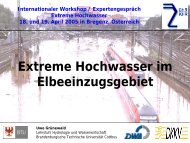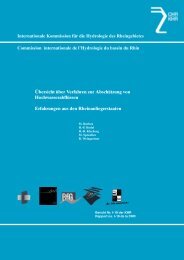ABSTRACTS 'Extreme Discharges' - CHR-KHR
ABSTRACTS 'Extreme Discharges' - CHR-KHR
ABSTRACTS 'Extreme Discharges' - CHR-KHR
You also want an ePaper? Increase the reach of your titles
YUMPU automatically turns print PDFs into web optimized ePapers that Google loves.
Increasing flood losses indicate increasing flood risk -<br />
What are the responsible parameters?<br />
Wolfgang Kron<br />
Münchener Rück, München<br />
Königinstrasse 107, D-80791 München, Germany<br />
wkron@munichre.com<br />
Increasing flood losses<br />
Flood catastrophes and the resulting economic and insured losses have increased significantly in the past decades.<br />
About a third of the economic catastrophe losses incurred worldwide are due to the effects of floods; more<br />
than half of all the people that were killed in the natural catastrophes of recent decades were the victims of<br />
floods. In global terms, the great flood catastrophes of the 1990s alone accounted for losses exceeding<br />
US$200bn (Tab. 1). The comparison of decade figures clearly shows dramatic increases.<br />
Table 1: Great flood catastrophes 1950–2004, decade comparison<br />
1950–<br />
1959<br />
1960–<br />
1969<br />
1970–<br />
1979<br />
1980–<br />
1989<br />
1990–<br />
1999<br />
1995–<br />
2004<br />
Factor: last<br />
10 yrs. : 60s<br />
Number 6 6 8 18 26 15 2.5<br />
Economic 32 23 21 30 245 154 6.7<br />
losses<br />
Insured<br />
losses<br />
0.0 0.25 0.4 1.6 8.8 8.3 33<br />
MRNatCatSERVICE - Losses in US$ bn, 2004 values © Munich Re, Geo Risks Research – January 2005<br />
Central Europe has experienced large events almost every other year during the past decade. The 1993 and 1995<br />
floods in the Rhine system were followed by the Odra flood in 1997 and the Whitsun flood in Southern<br />
Germany in 1999, and all these were dwarfed by the Elbe flood in August 2002. Then, Germany suffered<br />
losses of €11.6bn, Austria and the Czech Republic added another €3.1bn and €3.0bn, respectively.<br />
What is risk?<br />
When talking about "increase in losses", it is important to distinguish the terms hazard and risk. While hazard is<br />
the existence of a possibly dangerous natural phenomenon and the probability of an extreme manifestation of<br />
that phenomenon, risk also looks at what may happen in that case. In the scientific community it is widely<br />
agreed that risk is the product of a hazard and its consequences. Hence, three components determine the risk:<br />
1. the hazard i.e. the threatening natural event including its probability of occurrence;<br />
2. the exposure, i.e. the values/humans that are present at the location involved;<br />
3. the vulnerability, i.e. the lack of resistance to damaging/destructive forces.<br />
In its most simple form risk is computed by multiplying these three components.<br />
From this definition follows that:<br />
1. Where natural forces are gentle or where destructive events happen extremely seldom, the risk - in general - is<br />
low.<br />
2. Where there are no people or values that can be affected by a natural phenomenon, there is no risk. In a similar<br />
way a disaster can only happen when people are harmed and/or their belongings damaged.<br />
3. Where people are well prepared, the impacts of nature's forces may be kept at a low level; therefore, the risk<br />
is low.<br />
57





